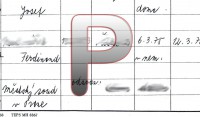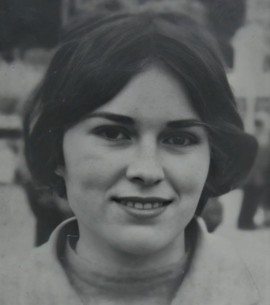12.3.1975 and the aftermath
 The date was Wednesday, March 12, 1973, time shortly before six o’clock in the morning. Waiting in the basement of the main Pankrác prison building were four men. Above them, ascending the stairs leading to the cellblock, were another three. As they continued through the hallway, they stopped at the door of one of the cells there – one of those six cells that were known as the "death cells". Here, the prisoners condemned to death were spending their last weeks-months before their execution. Meanwhile, a wakeup call had just sounded. The men opened the cell where Olga Hepnarová had been confined and ordered her to get herself ready for the escort. The three men who came for her together with the shift leader – that was the hangman himself and his two helpers. After applying handcuffs on her and restraining her with the belt, the helpers, each from one side, grabbed her by the hand and led her through the hallway and then downstairs, with the hangman walking a couple of steps behind them. Within a few minutes, they finally reached the aforementioned basement. Before them was a door, painted in dark green and heavily padded, followed by another, common-type door. After passing it, they entered the first and also the largest of the three rooms designed for carrying out the executions. In the room was a desk covered by a white tablecloth and with two rickety chairs behind it. Here, the four aforementioned men were waiting – the presiding judge of the Prague’s City Court (JUDr. R. wasn’t present, he was represented by another judge), the prosecutor, the prison’s chief officer, and the doctor. The convict was now standing before them. First, the presiding judge read the operative part of the judgment and then the announcement which stated that the verdict of death penalty had been deemed as thoroughly lawful and thus upheld by the Supreme Court of ČSSR in its reviewing proceedings. In the end, he advised the convict that her request for pardon had been declined. He then asked the doctor for his stance. The doctor confirmed that the convict isn’t pregnant, after which the presiding judge concluded that there aren’t any legal obstacles which would prevent the execution from taking place. He then signaled the hangman to take charge of things. The helpers took the convict to the second room and positioned her atop a metal trapdoor with a size of approximately 60x60 cm, located close to the wall. Around 2,30 m above the trapdoor, an iron pipe with a rope wrapped around it was sticking out of the wall. The hangman then wrapped the noose around the convict’s neck and went over to the third, smallest room, which contained the lever for operating the trapdoor’s mechanism. After being signaled by the helpers, he pushed the lever to the wall, which caused the trapdoor to open and the convict then “slipped” some 30 or 40 cm below the floor level ....... circa 15 minutes later, the doctor officially confirmed the death of Olga Hepnarová.
The date was Wednesday, March 12, 1973, time shortly before six o’clock in the morning. Waiting in the basement of the main Pankrác prison building were four men. Above them, ascending the stairs leading to the cellblock, were another three. As they continued through the hallway, they stopped at the door of one of the cells there – one of those six cells that were known as the "death cells". Here, the prisoners condemned to death were spending their last weeks-months before their execution. Meanwhile, a wakeup call had just sounded. The men opened the cell where Olga Hepnarová had been confined and ordered her to get herself ready for the escort. The three men who came for her together with the shift leader – that was the hangman himself and his two helpers. After applying handcuffs on her and restraining her with the belt, the helpers, each from one side, grabbed her by the hand and led her through the hallway and then downstairs, with the hangman walking a couple of steps behind them. Within a few minutes, they finally reached the aforementioned basement. Before them was a door, painted in dark green and heavily padded, followed by another, common-type door. After passing it, they entered the first and also the largest of the three rooms designed for carrying out the executions. In the room was a desk covered by a white tablecloth and with two rickety chairs behind it. Here, the four aforementioned men were waiting – the presiding judge of the Prague’s City Court (JUDr. R. wasn’t present, he was represented by another judge), the prosecutor, the prison’s chief officer, and the doctor. The convict was now standing before them. First, the presiding judge read the operative part of the judgment and then the announcement which stated that the verdict of death penalty had been deemed as thoroughly lawful and thus upheld by the Supreme Court of ČSSR in its reviewing proceedings. In the end, he advised the convict that her request for pardon had been declined. He then asked the doctor for his stance. The doctor confirmed that the convict isn’t pregnant, after which the presiding judge concluded that there aren’t any legal obstacles which would prevent the execution from taking place. He then signaled the hangman to take charge of things. The helpers took the convict to the second room and positioned her atop a metal trapdoor with a size of approximately 60x60 cm, located close to the wall. Around 2,30 m above the trapdoor, an iron pipe with a rope wrapped around it was sticking out of the wall. The hangman then wrapped the noose around the convict’s neck and went over to the third, smallest room, which contained the lever for operating the trapdoor’s mechanism. After being signaled by the helpers, he pushed the lever to the wall, which caused the trapdoor to open and the convict then “slipped” some 30 or 40 cm below the floor level ....... circa 15 minutes later, the doctor officially confirmed the death of Olga Hepnarová.
The events that surrounded the execution are to this day subject of many articles and discussions among the people. Some of these rumors – even though unsubstantiated – have circulated in the public so frequently that they literally became the core facts of the whole case. Often, it is mentioned how frightened Olga Hepnarová appeared before the execution, how ferociously she fought on her way to the gallows (allegedly, she had to break or bite the hangman one of his fingers, other sources claim that the one who got injured was actually the hangman’s helper) and what other events (the author of the book about Olga Hepnarová politely referred to it as “disgusting details”) surrounded the whole execution – all this in stark contrast to her behavior at the police and later during her trial, where she demanded a death penalty for herself and also proclaimed of having absolutely no fear of it. In fact, the author of the book about Olga Hepnarová was one of the first, if not the very first person, to quote that fateful passage from the Bohumil Hrabal’s book Ponorné říčky („Underground rivers“ in English). When quoting it, however, he immediately put an asterisk to it, describing it as a “more or less imaginary confession of a police hangman”. In the Hrabal’s book, we can (literally) read the following: “... Personally, I’m against the death sentence, the execution by hanging, since the moment I hanged this one cute young gal who had happily circled around Štrosmajerák 1 for so long till there were enough people standing at the tram stop – enough for her to grow some serious balls and kill six of them with a pick-up truck, that is ... for this, she had been condemned to death, but before I could take her to the gallows and hang her, she would defecate, wet herself and throw up, making my job as a hangman totally disgusting ... hence, that’s why I am against the death penalty! ...” The aforementioned quote was then picked up by many journalists, people who were writing on the case on the web or in various articles (on many message boards, the users referred to this quote as a verified and substantiated fact), and then another dozens of journalists, who simply copied what had already been written. Some of them began referring to it as a “confession of a hangman” which Hrabal once recorded and then published, while others omitted the writer completely from the equation, so nowadays, we can also come upon articles that refer to the quote as an authentic testimony of a hangman. What we have to remember, though, is that Hrabal’s “Prague hangman” is nothing more than a literary character, so it is highly unlikely that the events mentioned in the book are indeed based on true facts. As an example of this, Hrabal’s book also mentions the story “of the Prague hangman hanging a young man who, when working as a projectionist in the Metro cinema, killed a young boy by cutting him to pieces with scissors” (note: the case of Jaroslav Papež, executed in 1967). Now, the description of the events goes like this – “But imagine this guy’s nature! Just before his execution, he was visited in his cell by his mother, and I could only barely wrestle a long nail from his hands, which he intended to pierce the mother with ..... Please tell me, how and who could’ve passed him that nail in his cell?, screamed the Prague hangman in anger as he got up and started walking with Písečný 2 back and forth .....”. Same as with Olga Hepnarová, here Hrabal again used a real character (i.e. Papež), but attached a fictional story to it. Even if we forgive the writer the "mysterious" appearance of a long nail in Papež’s cell, alone the idea of Papež’s mother being with him in his cell on the eve of his execution is borderline absurd and nonsensical (until the end of 1954, the prisoners condemned to death were able to know the date of their execution beforehand and as such were also allowed to write their last letters or meet with the family members during the so-called “farewell night”, but definitely not in the cell, and not everyone of them, as this right usually belonged to those who were condemned due to political reasons). Nevertheless, it’s still entirely possible that some of these “disgusting details” may’ve indeed surrounded the Olga Hepnarová’s execution. As every forensic pathologist will confirm you, the spontaneous opening of sphincters is nothing uncommon during the executions, especially when the cause of death is deemed as strangulatio, i.e. asphyxiation by hanging.
The mention about a possible incident during the execution where Olga Hepnarová had to allegedly bite or break the hangman or his helper one of his fingers firstly appeared in the mid-1990s in an article written by a female journalist H, who, back then, labeled it as an interview with the alleged hangman. As soon as the article appeared on the web, however, there was a comment made by one of the readers who evidently had a much better knowledge of things (note: I personally assume him to be one of the former members of the SNV PP). In the comment, you can also read the following – “I believe that, back in the day when Mrs. H. did this interview (I know her personally, by the way), she had been fooled by one of the former SNV members, who, judging from the events described in the article, may’ve once served at Pankrác, so theoretically, he may’ve heard something about the executions that took place there from his fellow senior members“. Aside from the aforementioned incident, the article also contained many erroneous facts, which obviously must’ve been mentioned correctly had there been a real hangman in the interview.

Nevertheless, what’s far more important than the aforementioned article is the official report on the execution entitled “Protocol on carrying out the death sentence”. This document contained a detailed description of the actual execution including the very behavior which the convicted person displayed during it. In the document about Olga Hepnarová’s execution, however, there's no mention of any such incidents at all.
...the aftermath
 Immediately after the convict’s death, the doctor present at the execution issued a death certificate. Within a couple of hours, the employees of the funeral home along with one appointed SNV member (usually one of the hangman’s helpers) then transported the body for cremation (this task had to be approved by written consent from the presiding judge). Following the cremation, the urn was then transported back to the Pankrác prison, where it was kept until the legal circumstances allowed the prison to hand it over to the family. The day after the execution, i.e. on March 13, 1975, the prison sent the ONV committee and its register of deaths a written confirmation on the execution. On the same day, the prison also sent a written notification to the mother of the convict, however, the letter eventually reached her no sooner than four days later. On March 18, 1975, the personal belongings of the convict were sent to the State Notary’s Office in Prague 1 and then handed over to the family. One interesting thing in the end: it took me some time to finally dig out the records on the performed cremation, as these documents didn’t contain Olga Hepnarová’s name but instead only her prison number.
Immediately after the convict’s death, the doctor present at the execution issued a death certificate. Within a couple of hours, the employees of the funeral home along with one appointed SNV member (usually one of the hangman’s helpers) then transported the body for cremation (this task had to be approved by written consent from the presiding judge). Following the cremation, the urn was then transported back to the Pankrác prison, where it was kept until the legal circumstances allowed the prison to hand it over to the family. The day after the execution, i.e. on March 13, 1975, the prison sent the ONV committee and its register of deaths a written confirmation on the execution. On the same day, the prison also sent a written notification to the mother of the convict, however, the letter eventually reached her no sooner than four days later. On March 18, 1975, the personal belongings of the convict were sent to the State Notary’s Office in Prague 1 and then handed over to the family. One interesting thing in the end: it took me some time to finally dig out the records on the performed cremation, as these documents didn’t contain Olga Hepnarová’s name but instead only her prison number.


Used abbreviations:
ČSSR – Československá socialistická republika; The Czechoslovak Socialist Republic
ONV – Obvodní národní výbor; District National Committee
SNV – Sbor nápravné výchovy; Correctional Education Corps
SNV PP – Sbor nápravné výchovy Praha Pankrác; Correctional Education Corps Prague Pankrác
Notes:
1 colloquial name for the Strossmayer’s Square in Prague
2 one of the characters in the Hrabal’s book Ponorné říčky
The above posted quotations origin from the book Ponorné říčky, written by Bohumil Hrabal and published in 1991 by Pražská imaginace, contains 104 pages, ISBN: 80-7110-025-0.



